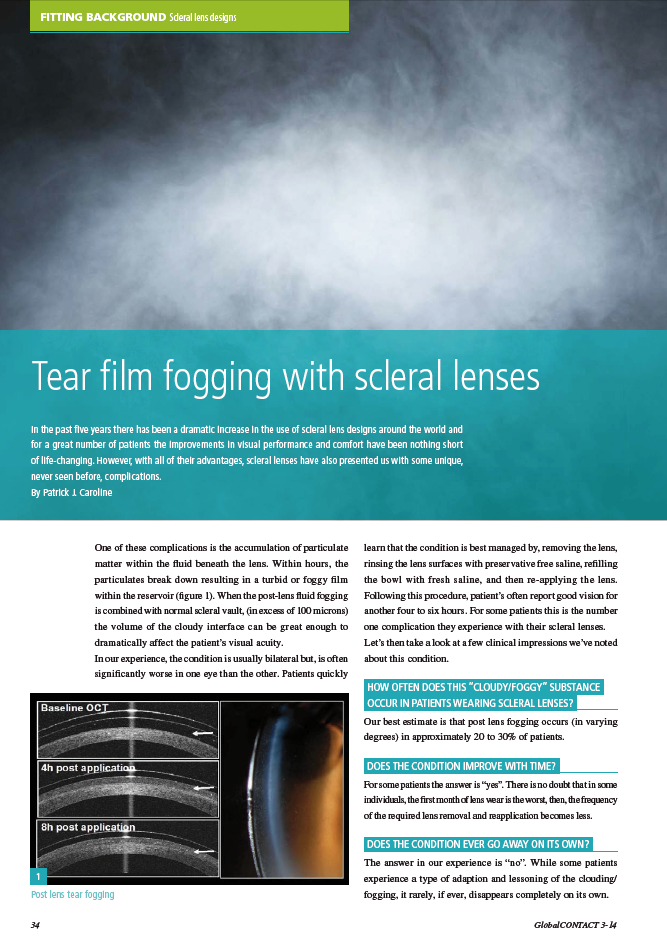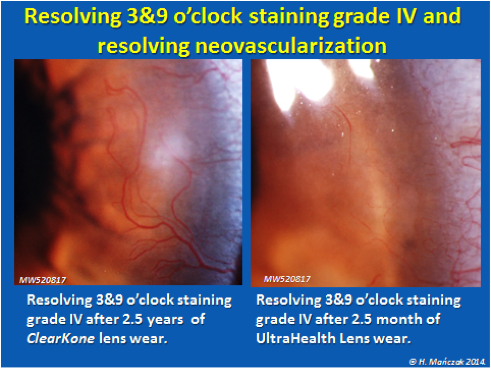|
|

International Newsletter and Forum on Rigid Gas Permeable Contact Lenses, Corneal Shape, Health and Vision |
|
|
|
|
|
|
|
|
|
|
Conjunctival Time
 Although not one of the main topics that this newsletter covers - I think it may be time (and fair) to spend a little time on the conjunctiva. It is actually on the conjunctiva that scleral lenses land. However, because the conjunctiva has no structure in itself but rather follows the scleral contour, the shape of the anterior eye beyond the corneal borders in scleral lens fitting is referred to as "scleral shape." The conjunctiva is a mucous membrane consisting of loose, transparent, vascular connective tissue. It is loose to allow free and independent movement over the globe. The conjunctiva consists of an epithelial and a stromal layer. At the limbus, the five layers of the corneal epithelium form into the 10-15 layers of the conjunctival epithelium. The conjunctival stroma is made up of loosely arranged bundles of coarse collagen tissue. In older age groups, the conjunctival epithelium seems to be more irregular from a morphological standpoint. The thickness of the conjunctiva can vary significantly - among individuals and also among different studies, the outcomes seem to vary. This may be due to the fact that it is hard to measure the thickness of such a soft mucous membrane. OCT studies by Zhang et al (2013) in Chinese eyes have revealed that the average conjunctival thickness (epithelial and stromal conjunctiva together) is in the 240 micron range - however, in their study population (ages 28 to 76), this ranged from a minimum of 140 microns to a maximum of 304 microns. Age demonstrated a significant correlation with conjunctival thickness, showing a reduced thickness with time. However, between the ages of 20 and 60, only a faint decrease in conjunctival thickness was seen - followed by a sharp decrease after the age of 60. A recent Japanese study by Igarashi et al found significant differences in conjunctival sensitivity between lens wearers and non-lens wearers in different locations on the conjunctiva - in which lens wearers (both (R)GP and soft) showed a higher sensitivity. Although not one of the main topics that this newsletter covers - I think it may be time (and fair) to spend a little time on the conjunctiva. It is actually on the conjunctiva that scleral lenses land. However, because the conjunctiva has no structure in itself but rather follows the scleral contour, the shape of the anterior eye beyond the corneal borders in scleral lens fitting is referred to as "scleral shape." The conjunctiva is a mucous membrane consisting of loose, transparent, vascular connective tissue. It is loose to allow free and independent movement over the globe. The conjunctiva consists of an epithelial and a stromal layer. At the limbus, the five layers of the corneal epithelium form into the 10-15 layers of the conjunctival epithelium. The conjunctival stroma is made up of loosely arranged bundles of coarse collagen tissue. In older age groups, the conjunctival epithelium seems to be more irregular from a morphological standpoint. The thickness of the conjunctiva can vary significantly - among individuals and also among different studies, the outcomes seem to vary. This may be due to the fact that it is hard to measure the thickness of such a soft mucous membrane. OCT studies by Zhang et al (2013) in Chinese eyes have revealed that the average conjunctival thickness (epithelial and stromal conjunctiva together) is in the 240 micron range - however, in their study population (ages 28 to 76), this ranged from a minimum of 140 microns to a maximum of 304 microns. Age demonstrated a significant correlation with conjunctival thickness, showing a reduced thickness with time. However, between the ages of 20 and 60, only a faint decrease in conjunctival thickness was seen - followed by a sharp decrease after the age of 60. A recent Japanese study by Igarashi et al found significant differences in conjunctival sensitivity between lens wearers and non-lens wearers in different locations on the conjunctiva - in which lens wearers (both (R)GP and soft) showed a higher sensitivity. |
|
It's OSO important
 One of the largest and most prestigious orthokeratology meetings in the world, OSO 2014 (with over 200 participants) was recently held at the Gold Coast in Australia. Many topics, from the latest update on myopia control to safety in orthokeratology, were covered and discussed in depth. The same topics are subjects of interest in the international literature. A paper by Chan et al reported on orthokeratology-associated infectious keratitis in a tertiary care eye hospital in Hong Kong. Early clinical and microbiological diagnosis and intensive treatment, as well as good hygiene and clinical management, are key, they stated. The OSO is working on a protocol for best orthokeratology lens practices, an important development. Many efforts have been invested in slowing of the progression of myopia. Among the methods available, atropine administration and orthokeratology have probably proven to be most efficient. A study by Lin et al published in BMC ophthalmology (open access) that analyzed the efficacy of atropine and orthokeratology One of the largest and most prestigious orthokeratology meetings in the world, OSO 2014 (with over 200 participants) was recently held at the Gold Coast in Australia. Many topics, from the latest update on myopia control to safety in orthokeratology, were covered and discussed in depth. The same topics are subjects of interest in the international literature. A paper by Chan et al reported on orthokeratology-associated infectious keratitis in a tertiary care eye hospital in Hong Kong. Early clinical and microbiological diagnosis and intensive treatment, as well as good hygiene and clinical management, are key, they stated. The OSO is working on a protocol for best orthokeratology lens practices, an important development. Many efforts have been invested in slowing of the progression of myopia. Among the methods available, atropine administration and orthokeratology have probably proven to be most efficient. A study by Lin et al published in BMC ophthalmology (open access) that analyzed the efficacy of atropine and orthokeratology i n controlling myopia progression and elongation of axial length found overnight orthokeratology to be comparable with atropine in controlling myopia. Part of the key in the mechanism behind myopia control with corneal reshaping may be the induced wavefront aberrations during overnight orthokeratology, which was investigated by Lian et al and published in Eye & Contact Lens. Overnight orthokeratology caused unique changes in corneal thickness profiles at the vertical and horizontal meridians and increased corneal and ocular higher order aberrations related to corneal reshaping.
|
|
Parental Control

Cheung, Lam & Cho investigated the attitudes of parents toward the use of orthokeratology, daily wear soft lenses and spectacles for myopia control. The assumption was made that all three optical strategies were equally effective for myopia control. Telephone interviews were conducted with parents who responded to the advertisement for two myopia control studies, one on orthokeratology and one on soft lenses. Most of the 196 respondents (56% in the orthokeratology group and 44% in the soft lens group) were mothers, aged 36-45 years. Orthokeratology was the most commonly known myopia control strategy (86%). Most parents were of the opinion that children are old enough to wear contact lenses safely at the age of 15 years or later. For myopia control, safety was the major concern of the parents, but choosing between myopia control strategies was also affected by the effectiveness of myopia control and any additional benefit(s) provided by the strategy. Parents with a higher educational background and who were existing contact lens wearers had more confidence in allowing younger children to wear contact lenses.
|
Tear Film Fogging With Scleral Lenses
| |
|
'What (about) the FOG' - part III
 Both in the October and in the November
editions of the I-site newsletter, the topic of scleral lens fogging was covered. Another article by Patrick Caroline in Global Contact discusses the topic at another level and brings more clinical wisdom and tips into the equation. According to the author, the condition of fogging is usually bilateral, but is often significantly worse in one eye than in the other. Typically, there seems to be an improvement over time. In some individuals, the first month of lens wear is the worst; then, the frequency of the required lens removal and reapplications becomes less. The condition rarely, if ever, disappears completely on its own though, it seems. Fogging also is typically not associated with deposits or non-wetting on the lens surface, nor with underlying corneal edema. Fitting the lens with minimal clearance across the peripheral cornea and the limbus seems to lessen the formation/ accumulation of post lens tear film fogging. Patients can irrigate the eye with preservative free saline prior to lens application, and/or they can apply the lenses for ten seconds and then remove them. If the lenses are then rinsed and reapplied, the outcome sometimes can prove to be surprisingly effective.
|
3- and 9-o'clock staining
 | |
Photo: Halina Mańczak
|
This month's I(n)-site-the-practice is contributed by Halina Mańczak, from Poland. A 62-year-old female suffering from bilateral keratoconus since age 10 was referred because of (R)GP lens wear intolerance. There was grade 4 3- and 9-o'clock staining in both eyes as well as dellen, pronounced neovascularization and peripheral clouding at the horizontal axis of the cornea. To overcome the 3- and 9-o'clock staining, hybrid lenses were suggested and prescribed. After two weeks of (R)GP lens discontinuation, hybrid lenses were fitted. Symptoms and signs started to resolve right after the hybrid lens were dispensed. It took two months for large neovascularized vessels to decrease in diameter. In addition, the dellen healed, and the cornea became more transparent.
|
|
Upcoming Events
- Global Specialty Lens Symposium, Jan 22-25, Las Vegas (US)
- CLSS, March 14-15, Billund (Dk)
- AOMC, April 16-19, Houston (US)
- IACLE 3rd World Conference, May 24-28, Manchester (UK)
- BCLA, May 29-31, Liverpool (UK)
|
|
|
|
|
|
|
I-site is an educational newsletter that is distributed on a monthly basis and provides an update on rigid gas permeable related topics (scientific research, case reports and other publications worldwide). I-site is objective and non-political. Its editor Eef van der Worp, optometrist, PhD, FAAO, FBCLA, FIACLE, FSLS is a lecturer for a variety of industry partners, but is not related to any specific company. Please contact us at: i-site@netherlens.com.
|
|
|